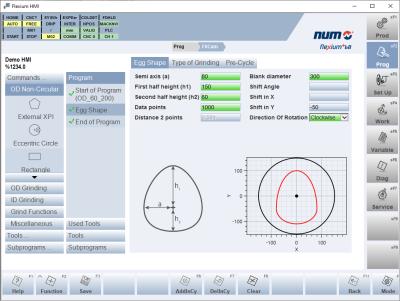
Powerful new software from NUM provides manufacturers of CNC cylindrical grinding machines with an elegant means of adding non-circular grinding capabilities to their products – without incurring significant development time and cost.
Non-circular grinding is used in a wide variety of automated manufacturing applications, such as the production of camshafts, crankshafts, cams and eccentric shafts. However, it is an extremely complex task, because the non-circular contour leads to constantly changing engagement and movement conditions between the grinding wheel and the workpiece.
NUM has now added non-circular grinding functionality to its NUMgrind cylindrical grinding software, which forms an application-specific element of the company’s renowned Flexium+ CNC platform. It is fully compatible with other Flexium software, from release 4.1.20.00 onwards.
NUMgrind is specifically designed to simplify the creation of G code programs for CNC grinding machines through the use of a highly intuitive graphical human machine interface (HMI), conversational-style ‘fill in the blanks’ type dialogues or a combination of the two.
Unlike conventional CAD/CAM workstation tools for generating CNC machine tool control programs, NUMgrind is intended for use in the production environment. It enables shop floor personnel to handle everyday machining tasks very quickly and efficiently – and the work can be easily shared amongst several people and several machines. The NUMgrind HMI can of course also be run on an office PC. Application-dependent projects, and the corresponding ISO part programs, can be created, tested with NUM’s Flexium 3D simulation software and transferred to the targeted machine.
The operator simply determines the sequence of the grinding process via the HMI and enters the necessary data for the grinding operations, grinding wheels and dressing operations in the dialogue pages. Programming is further simplified by the fact that the HMI is supported by a comprehensive library of predefined shapes, which includes eccentric circles, hexagons, pentagons, polygons, Reuleaux triangles and rhombi. The CNC program is then created completely automatically and stored in an executable form.
The closed shape of the workpiece is defined in the XY plane. However, grinding is performed by interpolating or synchronizing the X axis with the C axis (workpiece spindle). Axial movement in the Z axis can also be accommodated, by means of oscillation or ‘multi-plunge’. The Flexium+ CNC system’s NCK transforms the contour from the XY plane into an XC plane, and calculates the corresponding compensation and in-feed movements, taking the grinding wheel diameter into account. The speed profile is also transformed, so that the speed and acceleration are automatically adapted to suit the physical attributes of the machine.
Contact Details
Related Glossary Terms
- computer numerical control ( CNC)
computer numerical control ( CNC)
Microprocessor-based controller dedicated to a machine tool that permits the creation or modification of parts. Programmed numerical control activates the machine’s servos and spindle drives and controls the various machining operations. See DNC, direct numerical control; NC, numerical control.
- cylindrical grinding
cylindrical grinding
Grinding operation in which the workpiece is rotated around a fixed axis while the grinding wheel is fed into the outside surface in controlled relation to the axis of rotation. The workpiece is usually cylindrical, but it may be tapered or curvilinear in profile. See centerless grinding; grinding.
- dressing
dressing
Removal of undesirable materials from “loaded” grinding wheels using a single- or multi-point diamond or other tool. The process also exposes unused, sharp abrasive points. See loading; truing.
- grinding
grinding
Machining operation in which material is removed from the workpiece by a powered abrasive wheel, stone, belt, paste, sheet, compound, slurry, etc. Takes various forms: surface grinding (creates flat and/or squared surfaces); cylindrical grinding (for external cylindrical and tapered shapes, fillets, undercuts, etc.); centerless grinding; chamfering; thread and form grinding; tool and cutter grinding; offhand grinding; lapping and polishing (grinding with extremely fine grits to create ultrasmooth surfaces); honing; and disc grinding.
- grinding wheel
grinding wheel
Wheel formed from abrasive material mixed in a suitable matrix. Takes a variety of shapes but falls into two basic categories: one that cuts on its periphery, as in reciprocating grinding, and one that cuts on its side or face, as in tool and cutter grinding.

